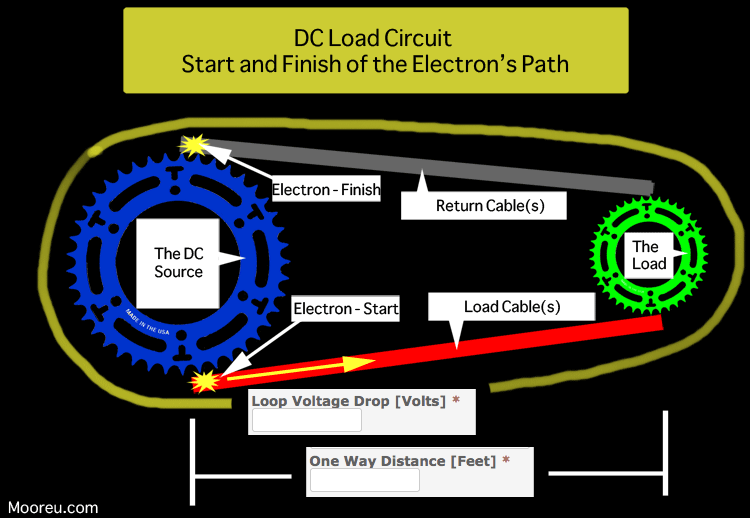| Sizing DC Power Cable for Voltage Drop | ||||||||||||||||||||||||||||||||||||||||||||||||||||||||||||||||||||||||||||||||||||||||||||||||||||||||||||||||||||||||||||
 = equals Typical value = 80% of Breaker Name Plate Rating - See below for suggested values. |
||||||||||||||||||||||||||||||||||||||||||||||||||||||||||||||||||||||||||||||||||||||||||||||||||||||||||||||||||||||||||||
 |
||||||||||||||||||||||||||||||||||||||||||||||||||||||||||||||||||||||||||||||||||||||||||||||||||||||||||||||||||||||||||||
 One (1) Way Distance from Power Source to Load along the ladder rack path. |
||||||||||||||||||||||||||||||||||||||||||||||||||||||||||||||||||||||||||||||||||||||||||||||||||||||||||||||||||||||||||||
 |
||||||||||||||||||||||||||||||||||||||||||||||||||||||||||||||||||||||||||||||||||||||||||||||||||||||||||||||||||||||||||||
 Typical Loop Voltage Drop values are listed in Table 3 - see below |
||||||||||||||||||||||||||||||||||||||||||||||||||||||||||||||||||||||||||||||||||||||||||||||||||||||||||||||||||||||||||||
 |
||||||||||||||||||||||||||||||||||||||||||||||||||||||||||||||||||||||||||||||||||||||||||||||||||||||||||||||||||||||||||||
F) PROTECTOR SIZING:
1) Fuses:
1.1 Maximum Demand Current (List II Drain) x 150% = Fuse size
2) Breaker:
2.1 Maximum Demand Current (List II Drain) x 125% = Breaker Size
3) Non-KS Type Circuit
Breaker:
3.1 Maximum Demand Current (List II Drain) x 150% = Circuit Breaker Size
G) DC
POWER CABLES:
1) Engineering Fundamentals:
1.1 Primary Power Cables are the cables that run from the Power Plant to the BDCBBs. 1.2 Secondary Power Cables are the cables that run from the BDCBBs to the Equipment. 1.3 Battery Power Cables are the cables, which run from the power plant to the batteries. 1.4 Vertical runs of power cable, which extend more than 3 floors, shall be provided with twenty feet of horizontal cable run out every third floor to alleviate weight buildup. 1.5 MCM = Thousand Circular Mills; KCM = Thousand Circular Mills (also); AWG = American Wire Gauge. 1.6 General Rule: Bending radius = 10 x
(Diameter of cable)
Fig 2:
Allowable Loop Voltage Drop:
* Voltage Drop A: 0.25V
ballpark, but dependant upon customer
* Voltage Drop B: 1.0V
ballpark, but dependant upon customer
* Voltage Drop C: 0.75V
ballpark, but dependant upon customer
Table 3:
Customer Specific Loop Voltage Drops
2) Sizing
Power Cables:
2.2 Voltage Drop:
o
Second Determine if the
cable is large enough for the Voltage Drop
o
Allowable Voltage Drops
vary per customer, but if there is not a customer guideline, use the values in
Figure 2 above.
o
The longer a cable is, the
greater the Voltage Drop.
o
Measure the loop length
the cable will have to be run.
o
To determine the Cable
size to carry the Voltage:
CM = ((K x Amps x Distance)/ (Loop Voltage Drop))
o
Where:
§
CM = Circular Mills (Use Table 4 to determine the CM of each cable type)
§
K = 11.1 (constant used when ft, amps, and volts are used)
§
Amps = Max Load (Usually 80% of the breaker size) the cable will need to
carry
§
Distance is the Loop distance
in feet from the Power Source to the Equipment and back measuring along the
ladder rack. (Do not count the distance to drop into the bay)
§
Loop Voltage Drop Varies per customer (See Table 3 for Specific Customer
Voltage Drops)
2.3 Example: 600 Amp BDCBB, 70 ft from PDF, 1.0V voltage drop, max draw is 480A
o
Amperage:
§
BDCBB is breakered out at 600 Amps (breaker
located in PDF); therefore the cable must be able to carry the current 600
Amps, or else the cable will become the fuse.
§
750MCM cable, which is the largest cable size, has an amperage value of
475 Amps per cable, which is less than the 600A.
§
Therefore, a minimum of (2) 350 MCM (Amperage is 310A, (2) 350MCM Cables will carry 620A) cables must be
used to carry 600 Amps.
·
Any number of cable combinations can be used provided there is enough to
cover the Circular Mills (CM) needed for the amperage and the voltage drop or
the customer requires something different.
o
Voltage Drop:
§
The Max Draw is 480 Amps (1.25 x 480A = 600A) and the allowable voltage
drop is 1V (loop distance = 2x70ft = 140ft):
§
Calculation of CM necessary for Voltage Drop:
·
CM = [(11.1)(480 amps)(140ft)/(1V)] = 745,920
·
745,920 is less than 750,000 so one 750MCM
cable would be able to handle the voltage drop. BUT…
·
Amperage dictates that there be 2 cables (Since the ampacity of 750MCM cable (475A) is less than 600A).
·
(745,920 CM)/2 Cables = 372,960 per cable
·
372,960 CM is greater than 350,000 CM, therefore at the minimum (2) 500MCM cables must be used.
·
See Table 4 for Circular Mills of Cables
·
2.4 Select Customers/End-Users: Size the amperage of the cable to greater than the amperage of
the breaker (as usual) but, size the
voltage drop of the cable to half the breaker size.
o
Load A powers half the equipment’s
load and Load B powers the other half. Therefore, the cabling to each load only needs to pull half the
amps. However, if load A fails,
Load B must deliver power to Load A’s equipment. So the Amperage of the cable must be prepared to handle this
situation.
o
Example: Breaker size = 400A, Each
load (A & B) of the BDFB will be delivering 200A to the Equipment:
§
Size Amperage of Cable to greater than 400 Amps
§
Size Voltage Drop to 200A per load.
§
If one load of the BDFB Fails, the other will cover for the failed load,
which is why the amperage of the cable has to be greater than the breaker size.
·
The Voltage drop will be greater than desired since the cable was sized
to 200A, but it is only a temporary situation until the other load is working.
Table 4: General Cable Information
* Max Amperage on Cable
Rack is for insulated conductors rated 0-2000V @ 75C or 167F (NEC 2011) Table:
310.15(B)(16)
* Weights and O.D. are industry approximates. May vary
for different cables and different manufacturers.
3)
Considerations:
3.1 Can the cable
support the Amperage and Voltage Drop?
3.2 Flex Cable or
Non-Flex
3.3 Color of Cable,
Braided or PVC etc..
3.4 Does the Customer/End-User
require no smoke, Zero Halogen?
|
||||||||||||||||||||||||||||||||||||||||||||||||||||||||||||||||||||||||||||||||||||||||||||||||||||||||||||||||||||||||||||
| For assistance, please call (610)952-6067 or email mike@mooreu.com | ||||||||||||||||||||||||||||||||||||||||||||||||||||||||||||||||||||||||||||||||||||||||||||||||||||||||||||||||||||||||||||


